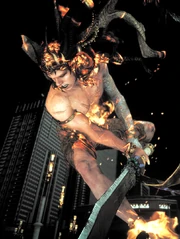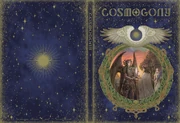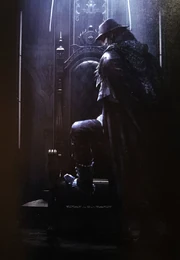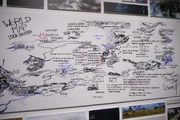Our story takes place in the land of Eos. At present, the world is divided between two warring states. Controlling a majority of the world’s lands is the militarily mighty Niflheim, an aggressively expanding imperial war machine. The Kingdom of Lucis continues to resist the empire’s advance with magic. The Crown City of Insomnia stands proud as the kingdom’s last bastion, but the empire has already made inroads on the outlying territories, including the primary regions of Leide, Duscae, and Cleigne.
Eos es uno de los mundos disponibles en la saga Final Fantasy.
Descripción[]
Eos es el mundo en el que transcurre la historia de Final Fantasy XV. A veces se hace referencia a este mundo como "la estrella" ((星, hoshi?)), y el tutorial de la historia en japonés sobre los seis Astrales y el Oráculo confirma que esta referencia es sobre Eos.
FFXV
Eos has two continents visited in the game, and largely temperate to arid climate, although areas of it have been transformed into snowfields due to magic. Eos is infected by a mysterious malady known as the Starscourge that lengthens nights. Eos has varied wildlife, but it has been mutating lately as found by hunters who note increasingly ferocious varieties of regular beasts appearing, and biologist Sania Yeagre who studies frog mutations.
Historia[]
Plantilla:See While information on the creation of Eos is lacking, it is known that the six Astrals were either created from or part of this process.[1] The six Astrals are Titan the god of earth, Ramuh the storm god, Leviathan the sea goddess, Shiva the goddess of ice, Ifrit the god of fire, and Bahamut the god of war. The Six are charged with defending Eos and its denizens from all threats—including each other. The eventual dominant species, humanity, were created in the image of the Astrals, and worshiped the Astrals despite their patrons having their own language and agendas divorced from human affairs.
In Final Fantasy XV: Episode Ardyn, Verstael Besithia's exhibition on the world puts worth the imperial take on the world's origins, estimating that Eos came into existence some 4.5 billion years ago and that six protector gods first alighted upon Eos in the ancient Solheim Era. Fossils thought to be remains of the oldest members of the human race were discovered in the Piztala region, and some claim that humans discovered fire in the Succarpe region even before the dawn of the Solheim civilization. According to legend, the fire god Ifrit first bestowed his "burning wisdom" upon a man who later sat the throne of Solheim.
Un meteorito cae en Eos, convirtiéndose en el llamado Meteoro de los Seis y sustentado por el dios Titán. De acuerdo con algunas fuentesPlantilla:Foot, el meteoro trajo consigo un parásito que acabaría siendo conocido como el "Starscourge". La línea temporal asociada a la caída del meteorito es desconocida.

Ifrit, el infernio
Solheim was a nation that prospered during the time Eos was under the watchful eyes of the Six, having gained the knowledge of fire from Ifrit. A technologically advanced nation, it was known for its magitek armor and airship technology. As Solheim spurned the gods, Ifrit's anger led to the War of the Astrals, and Solheim fell due to a combination of the Astral War and the Starscourge's influence.[2] Ifrit was killed in a final duel with Bahamut, and was laid to rest within the Rock of Ravatogh.
Final Fantasy XV -The Dawn of the Future- puts forth a different chain of events, where Bahamut had tried to destroy Eos during the war. While the other Astrals are bound to Eos and govern its natural forces, Bahamut exists in a separate dimension and apart from the planet, sitting above the other Astrals. Bahamut's attempt to lay waste to Eos was thwarted by the other Astrals, who were exhausted by the affair and fell into deep millennia-long slumber to recuperate. Unable to use Teraflare again so soon, Bahamut came up with a plan to purge the Scourge that had infected the planet.
Bahamut chose two mortal bloodlines to combat the Starscourge. The members of House Fleuret became the Oracles, and the Lucis Caelums would become the kings of Lucis, a kingdom established over the fallen Solheim. Ardyn Lucis Caelum was chosen by the Crystal to save Eos from the Starscourge. The Crystal holds the planet's soul and was given to the Lucis Caelum bloodline by the gods to protect. Ardyn absorbed countless daemons, nocturnal monsters born from Eosian natural life mutated by the parasite. Doing so made Ardyn the Starscourge incarnate and the Crystal rejected him. Ardyn was denied ascension to the throne and was succeeded by his younger brother Somnus. According to legend Somnus went on a quest with the first Oracle across Eos to forge covenants with the Astrals and banish the Starscourge from the world, although the veracity of this tale is ambiguous as Ardyn's presence has been erased from history books. Ardyn's corrupted soul has become immortal, and as long as he lingers the plague will not be fully cured.
Bahamut gifted Somnus the Crystal, the chrysalis for the soul of Eos and a divine artifact of great magical power, as well as the Ring of the Lucii, a royal heirloom that allows the ringbearer to command the Crystal's power and would bond Somnus's lineage's souls so the ancestors can empower the current monarch. Somnus's bloodline's divine mission is to guard the Crystal until the its Chosen King will be born, as though the initial plague had subsided, a prophecy of its return spread: "When darkness veils the world, the King of Light shall come."
Somnus established a kingdom to the east of where the now-ruined Solheim civilization used to be, which became known as Lucis. The world was left in ruin after the Astral War and the effects of the Starscourge, the Astrals slumbering in wait for the Chosen King, bar for Bahamut who waits the Crystal's Chosen to appear in his domain to grant him the knowledge of the Light of Providence.

Cover of Cosmogony illustrates Bahamut giving the Crystal to a king.
After the Astral War there was a long period of stability and peace, during which four new nations appeared: Lucis, Accordo, Niflheim and Tenebrae. Accordo, the smallest nation surrounded by water, grew commercially prosperous. The Empire of Niflheim, led by the Aldercapt dynasty, sought to revive the prosperity of the civilization of Solheim.[3] Lucis and Tenebrae were kingdoms led by the divine bloodlines tasked by the Astrals to herald the coming of the King of Light, Tenebrae being led by House Fleuret where a chosen female member would serve as the Oracle, able to heal those afflicted with the Starscourge. The gods had enabled the Oracle to commune with them, and sent divine Messengers to her to make the deities' will known to mankind. The Oracle's ultimate mission is to help the king of Lucis become the Chosen King. The now-dormant Astrals fell into legend, although it was said they were only sleeping, awaiting the prophesied time when the King of Light would arrive.
The plague from the time of Lucis's founding was re-introduced to the world when the Niflheim Empire began its territorial expansion and experimentation with daemons, expedited after Ardyn began to influence its political scene. Bolstered by its magitek infantry, Niflheim began to conquer the world. Lucis, protected by the light of the Crystal, resists invasion, and the reigning monarch upholds a magic barrier to protect the nation. While the Crown City remains shielded, daemons spawn all around the rest of Eos, and a mysterious "vanishing disease" ravages the imperial lands.
The nights grow longer and the daemons become increasingly ferocious, but Lunafreya Nox Fleuret, the current Oracle, works tirelessly to stop the world from plunging into an eternal night. She believes the time of the Chosen King has arrived, it being Noctis Lucis Caelum, the last of the line of Lucian kings, the 113th heir to the throne.

Ardyn Izunia.
The Niflheim Empire invades Insomnia and steals the Crystal. King Regis is killed and Prince Noctis embarks on a journey to reclaim his throne and save Eos from daemons and the Starscourge. He is guided by two opposing figures: Lunafreya who wants to see Noctis fulfill his destiny; and Ardyn, now going with the surname of Izunia, the chancellor of Niflheim whose true existence is that of the embodiment of the Starscourge as the immortal Accursed, his name scrubbed from history books. Ardyn guides Noctis to become the True King for he longs to see the Lucis Caelum dynasty extinguished and to get his revenge against the gods and the Crystal.
Lunafreya rouses the sleeping Astrals one by one and Noctis passes their Trials, though Leviathan's Revelation decimates the city of Altissia. After Ardyn murders Lunafreya, Eos is plunged into further chaos as the Starscourge spreads unopposed. When Noctis finds the Crystal, to his surprise he is absorbed inside it. In a realm bathed in light inside the Crystal he meets Bahamut who explains to him that the Crystal holds the soul of Eos, and that Noctis can wipe the Starscourge from the planet by killing Ardyn with the light of Providence at the cost of his own life.
Noctis sleeps inside the Crystal for ten years during which time Eos enters an eternal night and is overwhelmed by daemons. Mankind takes refuge in Lestallum, a town fending off the night with its power plant. A biologist by the name of Sania Yeagre studies the phenomenon of disappearing daylight, and posits she has found the nidus from whence it spreads from underground. Likely this means that the planet itself is infected, and thus countless daemons manifest from the ground itself after the sun is gone.

Sun rises upon Eos again.
Ten years later Noctis returns to Insomnia to fell Ardyn. The two duel both wielding the power of kings, but Noctis emerges victorious. He sits upon the throne and uses the Ring of the Lucii to summon the spirits of his ancestors who attack him one by one until Noctis is killed and his soul enters the realm between life and death. Noctis combines the powers of the Lucian kings to purge the Starscourge from Ardyn's soul. Daemons disappear and the sun again rises upon Eos.
Fin alternativo[]
Final Fantasy XV -The Dawn of the Future- muestra una cadena de eventos alternativa, en la que Ardyn acumula un grandísimo poder para que el Rey Verdadero purgue con el Anillo de los Lucii, y Bahamut decide seguir con su plan inicial de destruir Eos. Revives a Lunaferya y la envía a absorber la oscuridad con sus nuevos poderes oscuros, y junto a Noctis, Ardyn, los reyes antiguos y los otros Astrales, derrotan a Bahamut. La magia, los Astrales y el Cristal se desvanecen de Eos, pero antes de hacerse añicos, el Cristal purga a Eos absorbiendo todo el Starscourge, haciendo que el sol salga de nuevo. La humanidad vuelve a ser libre de elegir su propio destino, sin estar gobernados por dioses o por el Cristal.
Plantilla:Endspoiler
Ubicaciones[]
Continente de Lucian[]
- Cavaugh
- Insomnia
- Citadel
- Insomnia
- Leide
- Hammerhead
- Galdin Quay
- Angelgard
- Longwythe Peak
- Longwythe Rest Area
- Balouve Mines
- Crestholm Channels
- Formouth Garrison
- Prairie Outpost
- Keycatrich
- Keycatrich Trench
- Norduscaen Blockade
- Duscae
- Coernix Station
- Fociaugh Cavern
- Nebulawood
- Wiz Chocobo Post
- Disc of Cauthess
- Aracheole Stronghold
- Costlemark Tower
- Daurell Caverns
- Cleigne
- Lestallum
- Old Lestallum
- Cape Caem
- Meldacio Hunter HQ
- Greyshire Glacial Grotto
- Rock of Ravatogh
- Malmalam Thicket
- Vesperpool
- Myrlwood
- Steyliff Grove
- Pitioss Ruins
- Galahd
Accordian continent[]
- Accordo
Imperial continent[]
- Niflheim
- Succarpe
- Magna Fortia
- Calcano
- Cartanica
- Fodina Caestino
- Haulhex Armory
- Eusciello
- Vogliupe
- Ghorovas Rift
- Ueltham
- The Imperial Capital, Gralea
- Zegnautus Keep
- The Imperial Capital, Gralea
- Succarpe
- Tenebrae
- Piztala
- Pagla
- Ulwaat
- Zoldara Henge
- Piztala
- The Sathersea
Oceans[]
- Cygillan Ocean
Ancient locations[]
Tras las escenas[]
Desarrollo[]

The world as seen in the the tech demo released during Paris Games Week 2014.
The development team created a clay model of the in-game map early on, prior to constructing the overarching game. This initial mock-up determined the overarching scheme and became the basis for constructing the actual map. The initial map helped evaluate where it would make sense to have a journey by car, where it would make sense for players to explore, and where it would make sense to have the train ride sequence planned for the game. It also helped evaluate what kind of technology was needed to achieve all the elements within the map.[4]
The decision on whether to make Final Fantasy XV open world was the hardest. Some staff aggressively opposed the idea with the fear that introducing open world would lead the game feeling empty. Director Hajime Tabata felt that non-open world RPG released at 2016 would have players raising their eyebrows, especially when traveling the world is a big theme in the game. The story remains linear, but it is expressed in an open world.[5]

Big Bang, a Yoshitaka Amano painting.
The staff at first was not confident on their ability to deliver an open world game. Tabata told everyone it would be okay for the field to be empty, and offered Shadow of the Colossus as an example of an expansive game whose world is not littered with content. Comparing their team to games like Grand Theft Auto or Red Dead Redemption, some were overwhelmed thinking they cannot develop something like that, but the team gained confidence as they earned the know-how on technology. Towards the end of the development Tabata talked how looking at some of the global developers of open world games, they now see that they bring in a lot of people during the final phase, but this was something Tabata couldn't foresee, because it was the team's first foray into developing an open world game. This was one of the reasons that contributed toward the decision to delay the release for two months.[4]

"Idea Map" of the world shown at the 30th anniversary exhibition.
The developers aimed having the exploration of the world be a big part of the joy of playing. They wanted to give the player a feeling similar to visiting a foreign country and be excited about what lies around the next corner.[6] In hindsight, Tabata has wished the transition between the open-world design and and the more linear style was smoother. There ended up being big difference between when newcomers and veterans put down the game. Most of the core-series fans quit at Chapter 13, but the new players often quit at the point the game switched over to the linear style.[7]
Cultura[]
Eos appears to use a language understood by all nations and peoples, though class and region lends different accents. Signage language around Eos differs per region: Insomnia has a lot of Japanese, Lucian outlands use a lot of English, Altissia and Cartanica use some Italian, Tenebrae some French and Gralea some Latin. This is evident in the lodgings' names, the one in Cartanica called Vagoni Albergo di Cartanica (Wagon Hotel of Cartanica), the Tenebraen one being called Tenerae Roues du Repos (Wheels of Rest) and the ones in Gralea called Dormitorium Militum (military dorm).
Traffic in Eos is right-handed. Despite this, arrows appear on the roads outside the Citadel that go clockwise. When Noctis and his allies return to the Citadel at the end of Final Fantasy XV, the arrows are removed.
Galería[]
Etimología y simbolismo[]
Plantilla:Etym The coming of dawn is a theme in Final Fantasy XV.
Eos is sometimes referred to as a star, even if not one in celestial terms. It being referred to as a star may allude to its connection to the Crystal and its light, as the Crystal is said to hold "the soul of the star". This hearkens to past Final Fantasy games where the Crystal represents the life force of the world or life force of the universe in general. Souls returning to the planet's crystal upon death has also appeared as a form of afterlife.
Referencias[]
Plantilla:Citations
Plantilla:Navbox setting FFXV
- ↑ Plantilla:Refwebsite
- ↑ "Ancient history is marked by the prosperity of the civilization of Solheim. When this civilization was at its peak, the betrayal of one of the six Astral gods, Ifrit, led to a conflict known as the Great War of Old. This was fueled by the spreading of a mysterious parasite, causing the death of millions, and ultimately the fall of Solheim." The Complete Official Guide pg. 318
- ↑ Plantilla:Refwebsite
- ↑ 4,0 4,1 Plantilla:Ref
- ↑ Plantilla:Ref
- ↑ Plantilla:Ref
- ↑ Plantilla:Ref




